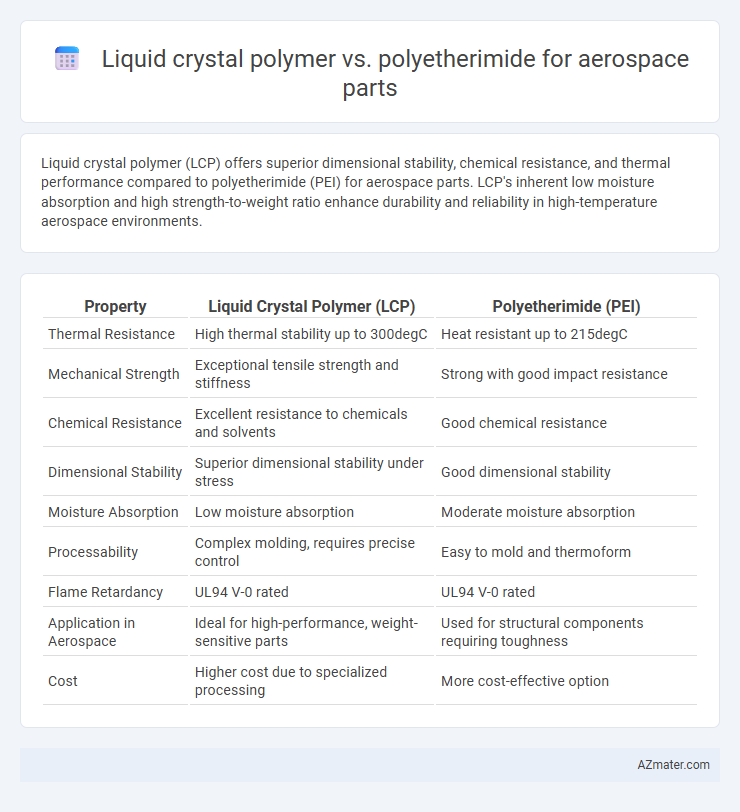Liquid crystal polymer (LCP) offers superior dimensional stability, chemical resistance, and thermal performance compared to polyetherimide (PEI) for aerospace parts. LCP's inherent low moisture absorption and high strength-to-weight ratio enhance durability and reliability in high-temperature aerospace environments.
Table of Comparison
| Property | Liquid Crystal Polymer (LCP) | Polyetherimide (PEI) |
|---|---|---|
| Thermal Resistance | High thermal stability up to 300degC | Heat resistant up to 215degC |
| Mechanical Strength | Exceptional tensile strength and stiffness | Strong with good impact resistance |
| Chemical Resistance | Excellent resistance to chemicals and solvents | Good chemical resistance |
| Dimensional Stability | Superior dimensional stability under stress | Good dimensional stability |
| Moisture Absorption | Low moisture absorption | Moderate moisture absorption |
| Processability | Complex molding, requires precise control | Easy to mold and thermoform |
| Flame Retardancy | UL94 V-0 rated | UL94 V-0 rated |
| Application in Aerospace | Ideal for high-performance, weight-sensitive parts | Used for structural components requiring toughness |
| Cost | Higher cost due to specialized processing | More cost-effective option |
Introduction to High-Performance Polymers in Aerospace
Liquid crystal polymer (LCP) and polyetherimide (PEI) are high-performance polymers widely utilized in aerospace for their exceptional thermal stability, mechanical strength, and chemical resistance. LCP offers superior dimensional stability and low moisture absorption, making it ideal for precision components exposed to extreme conditions. PEI provides excellent flame retardancy and impact resistance, supporting structural applications where durability and lightweight properties are critical.
Overview of Liquid Crystal Polymer (LCP)
Liquid crystal polymer (LCP) offers exceptional thermal stability, chemical resistance, and dimensional stability critical for aerospace applications requiring high-performance materials. Its unique molecular orientation provides superior mechanical strength and low moisture absorption compared to polyetherimide (PEI), enhancing durability in extreme environments. These properties make LCP ideal for manufacturing lightweight, high-precision aerospace components that demand consistent performance under thermal and mechanical stress.
Overview of Polyetherimide (PEI)
Polyetherimide (PEI) is a high-performance, amorphous thermoplastic known for its excellent mechanical strength, thermal stability up to 217degC, and inherent flame retardancy, making it ideal for aerospace applications requiring reliable performance under stress and temperature variation. Its low dielectric constant and excellent dimensional stability contribute to PEI's use in lightweight structural components and electrical insulation within aircraft systems. Compared to Liquid Crystal Polymer (LCP), PEI offers superior impact resistance and ease of processing, supporting the manufacture of complex aerospace parts with stringent safety and durability standards.
Mechanical Properties: LCP vs PEI
Liquid crystal polymer (LCP) exhibits superior tensile strength and stiffness compared to polyetherimide (PEI), making it ideal for aerospace components requiring high mechanical load resistance. LCP's excellent dimensional stability and fatigue resistance outperform PEI, especially under elevated temperatures and dynamic stress conditions. However, PEI offers better impact resistance and can tolerate higher continuous service temperatures, providing a balance of flexibility and strength for aerospace applications.
Thermal Stability and Heat Resistance
Liquid crystal polymer (LCP) offers superior thermal stability with a high melting point around 280-320degC, making it highly resistant to heat deformation in aerospace parts. Polyetherimide (PEI) also provides excellent heat resistance, maintaining structural integrity up to approximately 215degC but tends to soften at lower temperatures compared to LCP. The exceptional dimensional stability and chemical resistance of LCP under extreme thermal conditions make it the preferred choice for high-performance aerospace components exposed to continuous high temperatures.
Chemical Resistance Comparison
Liquid crystal polymers (LCPs) exhibit superior chemical resistance compared to polyetherimide (PEI), especially against strong acids, bases, and solvents common in aerospace environments. LCPs maintain structural integrity and resist degradation under prolonged exposure to aggressive chemicals, whereas PEI can experience swelling, discoloration, and reduced mechanical properties. This chemical durability makes LCPs preferable for aerospace components exposed to harsh chemical conditions and extreme service temperatures.
Weight and Density Considerations
Liquid crystal polymers (LCPs) exhibit significantly lower density, around 1.4 g/cm3, compared to polyetherimide (PEI), which typically has a density near 1.27 g/cm3, making LCPs advantageous for weight-sensitive aerospace applications. LCP's inherent molecular orientation also results in superior strength-to-weight ratios, enabling lighter parts without sacrificing mechanical performance. PEI, while slightly denser, offers excellent thermal stability and impact resistance but may add incremental weight to aerospace components where every gram matters.
Processability and Molding Capabilities
Liquid crystal polymer (LCP) offers superior flow properties and low melt viscosity, enabling precise molding of complex aerospace parts with high dimensional stability and minimal shrinkage. Polyetherimide (PEI) exhibits higher melt viscosity, which can challenge processing but provides excellent thermal resistance and structural strength once molded, suitable for aerospace components requiring durability. The advanced processability of LCP allows for faster cycle times and intricate geometries, while PEI demands more controlled molding conditions to achieve optimal mechanical performance in aerospace applications.
Application Case Studies in Aerospace
Liquid crystal polymer (LCP) demonstrates exceptional dimensional stability and chemical resistance in aerospace applications, making it ideal for components exposed to high mechanical stress and extreme temperatures, such as connectors and sensor housings. Polyetherimide (PEI) offers superior thermal stability and flame retardancy, often utilized in cabin interior parts and structural components requiring lightweight yet durable materials. Case studies show LCP's effectiveness in fuel system parts due to its low moisture absorption, while PEI is preferred for electrical insulation and structural supports in aerospace environments.
Cost Analysis and Material Selection Criteria
Liquid crystal polymer (LCP) offers superior mechanical strength, thermal stability, and chemical resistance compared to polyetherimide (PEI), making it ideal for high-performance aerospace parts requiring lightweight and durable materials. Although LCP tends to have a higher upfront cost, its enhanced machining efficiency and reduced waste contribute to lower long-term manufacturing expenses relative to PEI. Material selection criteria prioritizing operating temperature, dimensional stability, and cost-effectiveness typically favor LCP for critical aerospace components despite the premium material price.

Infographic: Liquid crystal polymer vs Polyetherimide for Aerospace part
 azmater.com
azmater.com